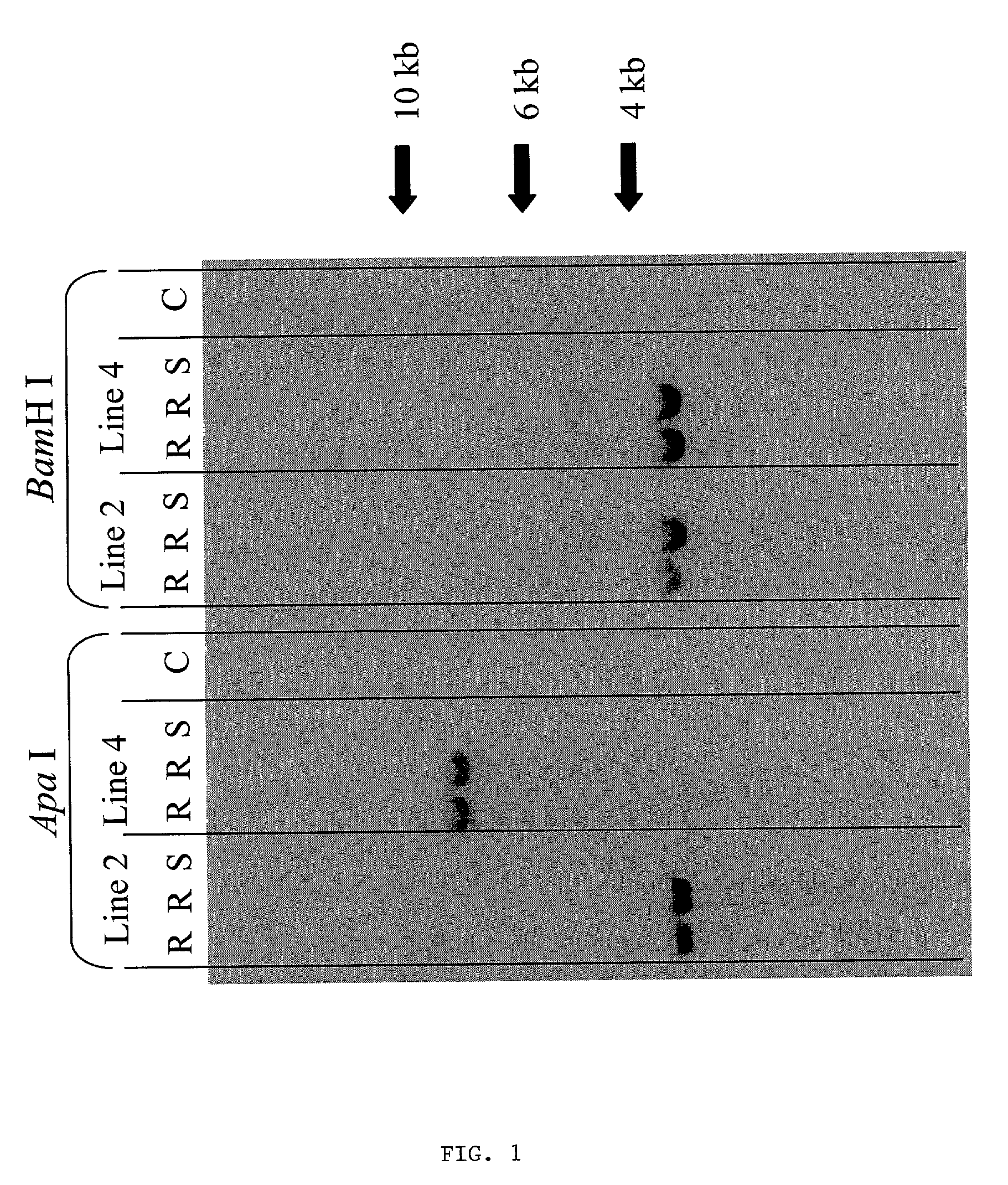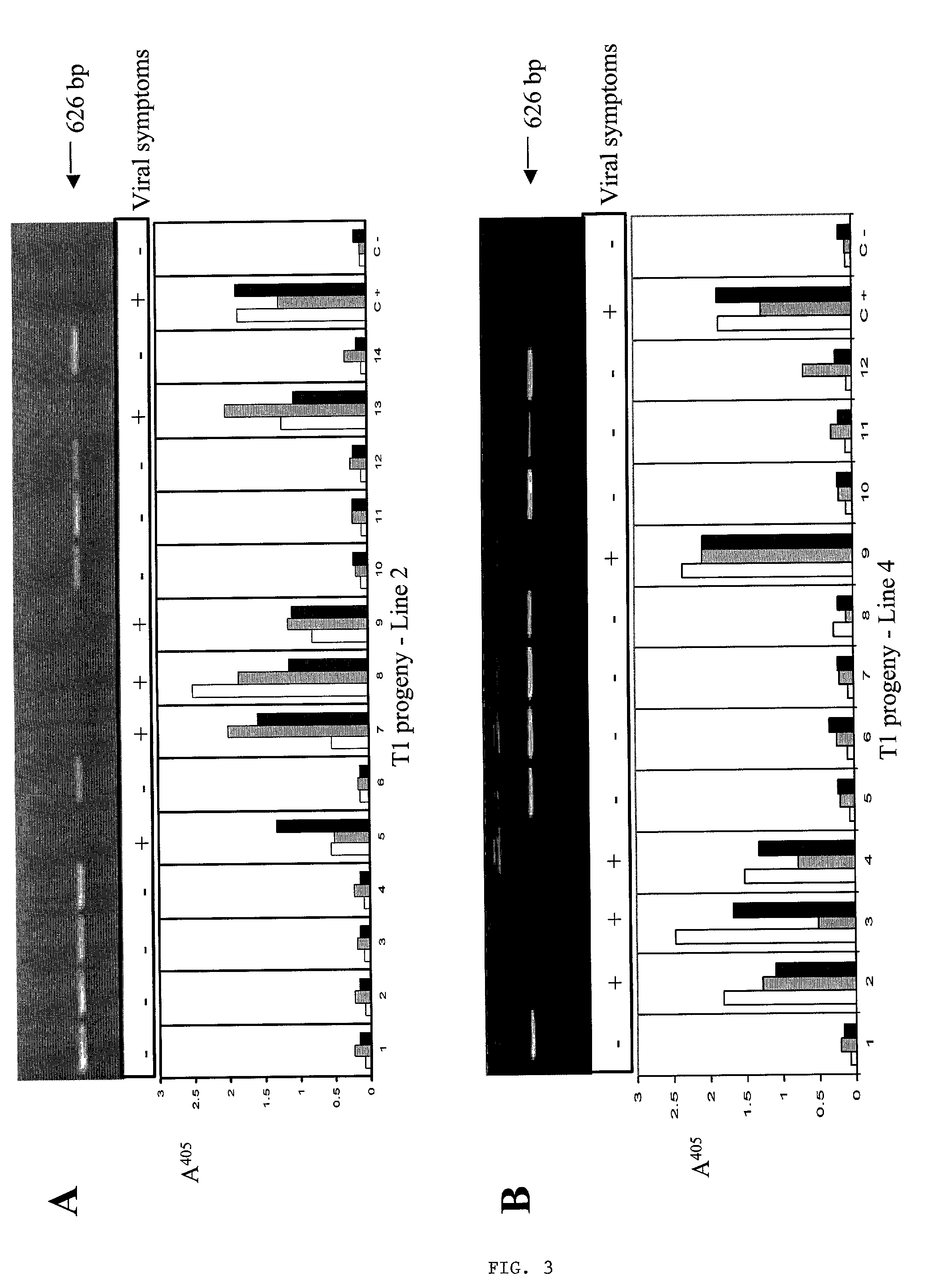Methods and means for producing barley yellow dwarf virus resistant cereal plants
a technology of yellow dwarf virus and cereal plants, which is applied in the directions of viruses/bacteriophages, organic chemistry, peptide sources, etc., can solve the problems of reducing the quality of grain, and reducing the number of sterile heads
- Summary
- Abstract
- Description
- Claims
- Application Information
AI Technical Summary
Benefits of technology
Problems solved by technology
Method used
Image
Examples
example 1
Construction of the Hairpin Gene (hpBYDVpol)
[0094] A full-length BYDV-polymerase (BYDVpol) sequence was amplified from a cDNA clone of an Australian BYDV-PAV isolate (GenBank Accession No. D11032) using GeneAmp XL PCR kit (Perkin Elmer), with a pair of primers (5'-ACCATTCTATTGTGCTCTCGCACAGAGATAAGCAGGAAACCATGGTTTTCGA AATACTMTAGGT-3' (SEQ ID No 3) and 5'-CCGGAATTCTTAATATTCGTTTTGTGAG-3' (SEQ ID No 4) that introduced a Nco I site and an EcoR I site at the 5' end and the 3' end, respectively. The underlined nucleotides are from the BYDV-PAV sequence. The resulting PCR fragment was digested with Nco I and EcoR I, and cloned into pUJJT (Wang and Waterhouse, 2000) at the corresponding sites, forming the Ubi1-JGMV5'-BYDVpol-tm1' cassette. A 1.6 kb sequence from the 5' half of BYDVpol was excised with Nco I and BamH I from the PCR fragment, treated with Klenow polymerase to generate blunt ends, and inserted into the EcoR I site (also pre-treated with Klenow) between BYDVpol and tm1' in the Ub...
example 2
Transformation and Analysis of T.sub.0 Plants
[0095] A gene construct (hpBYDVpol) was made in which a hairpin RNA, containing BYDV-PAV polymerase gene sequences, is transcribed under the control of the maize ubiquitin promoter (FIG. 1). Using this construct and an Agrobacterium-mediated transformation system, an overall transformation efficiency of 13% was achieved resulting in 38 independent transgenic barley plants (Table 1).
1TABLE 1 Transformation of barley with hpBYDVpol. Acetosyringone No. No. conc. in co- No. hygromycin transgenic Strain of cultivation scutella resistant calli lines Agrobacterium medium (.mu.M) used generated generated AGL0 0 72 40 (55%).sup.A 17 (24%) 200 70 40 (57%) 8 (11%) AGL1 0 71 17 (24%) 6 (8%) 200 72 22 (30%) 7 (10%) .sup.ANumbers in brackets = No. transgenic calli or plants / No. scutella (as a percentage)
[0096] Southern analysis indicated that 19 plants carried a single transgene copy, 12 contained two copies and 7 had three or more copies. The analysis...
example 3
Analysis of T.sub.1 Plants for Response to BYDV-PAV Inoculation
[0097] About 20 seed from each of the 6 T.sub.0 Lines were sown in soil. The resulting plants were inoculated with BYDV-PAV and assayed by ELISA three weeks later (Table 3).
3TABLE 3 Virus level, measured by ELISA, for groupings of highly resistant and susceptible T1 progeny of transgenic Lines 2 and 4, following inoculation with either BYDV-PAV or CYDV-RPV. Challenge virus CYDV-RPV Reaction to BYDV-PAV Highly infection Highly resistant Susceptible resistant Susceptible Line 2 0.103 .+-. 0.001.sup.A (9).sup.B 1.148 .+-. 0.074 (6) -(0) 1.136 .+-. 0.061 (15) Line 4 0.109 .+-. 0.036 (9) 1.741 .+-. 0.075 (3) -(0) 1.373 .+-. 0.107 (15) Control + 1.040 .+-. 0.172 (5) 1.070 .+-. 0.102 (6) Control - 0.105 .+-. 0.003 (6) 0.147 .+-. 0.003 (6) .sup.AELISA reading (with Standard Errors) of plants, 28 days post inoculation .sup.BNumbers of plants are shown in brackets Control + = challenged wildtype plants; Control - = unchallenged wi...
PUM
| Property | Measurement | Unit |
|---|---|---|
| pH | aaaaa | aaaaa |
| length | aaaaa | aaaaa |
| height | aaaaa | aaaaa |
Abstract
Description
Claims
Application Information
 Login to View More
Login to View More - R&D
- Intellectual Property
- Life Sciences
- Materials
- Tech Scout
- Unparalleled Data Quality
- Higher Quality Content
- 60% Fewer Hallucinations
Browse by: Latest US Patents, China's latest patents, Technical Efficacy Thesaurus, Application Domain, Technology Topic, Popular Technical Reports.
© 2025 PatSnap. All rights reserved.Legal|Privacy policy|Modern Slavery Act Transparency Statement|Sitemap|About US| Contact US: help@patsnap.com



